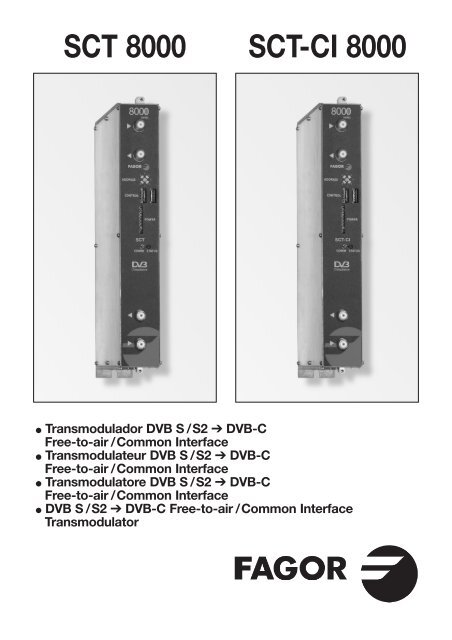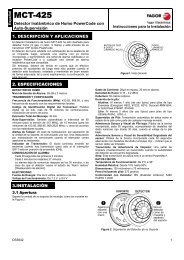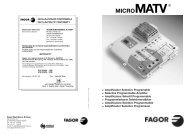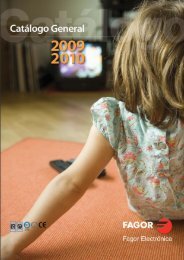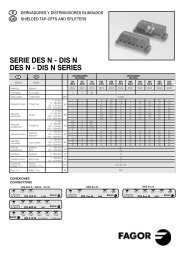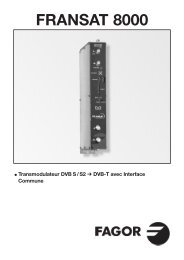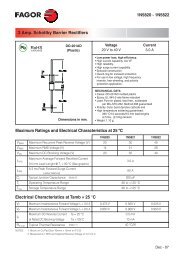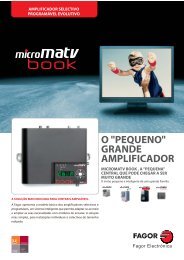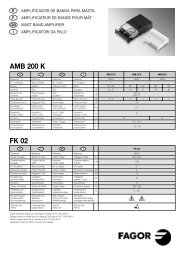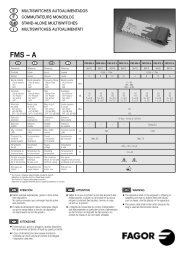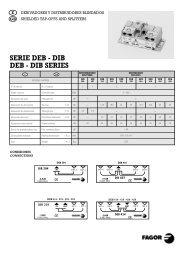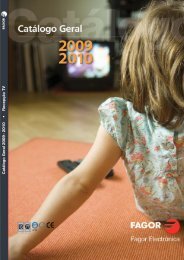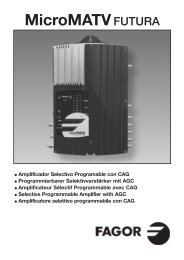Manual STT CI 8000(27-9-11) - Fagor Electrónica
Manual STT CI 8000(27-9-11) - Fagor Electrónica
Manual STT CI 8000(27-9-11) - Fagor Electrónica
- No tags were found...
You also want an ePaper? Increase the reach of your titles
YUMPU automatically turns print PDFs into web optimized ePapers that Google loves.
SCT <strong>8000</strong> SCT-<strong>CI</strong> <strong>8000</strong>● Transmodulador DVB S / S2 ➔ DVB-CFree-to-air / Common Interface● Transmodulateur DVB S / S2 ➔ DVB-CFree-to-air / Common Interface● Transmodulatore DVB S / S2 ➔ DVB-CFree-to-air / Common Interface● DVB S / S2 ➔ DVB-C Free-to-air / Common InterfaceTransmodulatorSATV
■ Fig. 2 EJEMPLO DE APLICA<strong>CI</strong>ÓNEXEMPLE D’APPLICATIONHousing mountingAPPLICATION EXAMPLEESEMPIO DI APPLICAZIONERack Mounting1313LNB 2 LNB 14412 5 1 12348 214251SHA SCT SCT SCT SCT ACM ACM SPS SAC SCT SCT SCT SCT ACM ACM SPS6 5 4 3 2 16 5 4 3 2 1IN <strong>27</strong> 65IN 3IN 4109- Plano de agujeros para el cofre- Piercing diagramme of the housing- Diagramme de perçage du boîtier- Plane fori per la cassettaNº E F UK I Housing Rack 19”1 Transmodulador Transmodulateur DVB S/S2 - DVB C Transmodulatore 08<strong>27</strong>0 SCTDVB S/S2 - DVB C DVB S/S2 - DVB C Transmodulator DVB S/S2 - DVB C 08<strong>27</strong>1 SCT-<strong>CI</strong>2 Amplificador SHA <strong>8000</strong> Amplificateur SHA <strong>8000</strong> SHA <strong>8000</strong> amplifier Amplificatore SHA <strong>8000</strong> 35083Amplificador SAC <strong>8000</strong> Amplificateur SAC <strong>8000</strong> SAC <strong>8000</strong> amplifier Amplificatore SAC <strong>8000</strong> 350813 Bus de alimentación Bus d’alimentation Supply bus Bus di alimentazione 838074 Fuente de alimentación SPS Alimentation SPS Power supply SPS Fonte di Alimentazione SPS 6<strong>8000</strong>5 Carga F, 75 Ω Charge F, 75 Ω F load, 75 Ω Carico F, 75 Ω 840<strong>11</strong>6 Puente RF Pont RF RF bridge Ponte RF 83814– Unidad de control UCF 300 Unité de contrôle UCF 300 UCF 300 control unit Unitá di controlo UCF 300 85<strong>11</strong>57 Bastidor pared Châssis mural Wall frame Telaio a muro 83805 –8 Bastidor Rack 19” 6U Châssis Panier 19” 6U 19” 6U rack frame Telaio Rack 19” 6U – 838009 Carátula adaptación Façade adaptation 19” source adaptation Copertina adattamentofuente 19” alimentation 19” front panel fonte 19”– 8380410 Carátula adaptación Façade adaptation 19” module adaptation Copertina adattamentomódulo 19” module 19” front panel modulo 19”– 83802– Cofre con bastidor Coffre avec châssis Howsing with frame Cassetta con telaioy aireación et aération and fan e ventilazione83806 –– Unidad de Unité d’aération Rack ventilation Unità di ventilazioneaireación Rack Panier unit Rack– 8380<strong>11</strong>1 Ventilador VNT 800 para Ventilateur VNT 800 pour Fan VNT 800 for Wall Ventilazione VNT 800 perBastidor BST 807 Châssis mural BST 807 frame BST 807 panello BST 80783818 –12 Modulador Modulateur DVB-ASI - DVB-C ModulatoreDVB-ASI - DVB-C DVB-ASI - DVB-C modulator DVB-ASI - DVB-C0820213 LNB 201 Universal LNB 201 Universel LNB 201 Universal LNB 201 Universale 861293Tab. 2
E■ DESCRIP<strong>CI</strong>ÓN● Transmodulador de señal DVB-S y DVB-S2 en DVB-CFree-to-Air (SCT <strong>8000</strong>) y con Acceso Condicional DVB-<strong>CI</strong>(SCT-<strong>CI</strong> <strong>8000</strong>). Admite señales de entrada QPSK u 8PSKy entrega señal modulada en QAM. Permite ver programasde satélite con receptores DVB-C. Los servicios con derechosde suscripción serán abiertos por el módulo de accesocondicional (CAM) (SCT-<strong>CI</strong> <strong>8000</strong>). La señal de 1ª FI SATcon programación digital se convierte a la banda de RFentre 50.5 y 858 MHz modulada en DVB-C.Gestiona señales MPEG-2 o MPEG-4 permitiendo haceruna selección de los programas que entrega en su salida.■ INSTALA<strong>CI</strong>ÓN Y PUESTA EN MARCHA- Las conexiones y desconexiones de los módulos serealizarán con la fuente de alimentación desconectadade la red.● Insertar la CAM y la tarjeta correspondiente en elequipo (ver ranura de inserción en el número 10 de lapágina 2) antes de colocarlo en el bastidor (SCT-<strong>CI</strong> <strong>8000</strong>).● Conectar la toma de tierra del bastidor a la tierra de lainstalación de la antena.● Sujetar los módulos en el bastidor según el ordenindicado en el ejemplo de aplicación, (ver Fig.2).Fuente de alimentación a la derecha y amplificadora la izquierda del conjunto.● Realizar la distribución de señal de la(s) antena(s) medianteel puente coaxial F-F (Ref. 83814) y cargar la(s) salida(s)libre(s) con 75 Ω (Ref. 840<strong>11</strong>).● Unir las Salidas de Canal RF (Fig.1, 8) mediante el puentecoaxial F-F, y cargar con 75 Ω la salida libre del módulo 1,junto a la Fuente de alimentación.● Conectar el Bus de Alimentación BA 807 ref. 83807entre los módulos (Fig.1, 5) y la Fuente de alimentación SPS.● Conectar los cables de bajada de las antenas en lasentradas correspondientes (Fig.1,1).● Conectar la Fuente de alimentación a la red eléctrica.■ TEMPERATURA DE FUN<strong>CI</strong>ONAMIENTO● Los módulos deben ser refrigerados para funcionarcorrectamente. Para ello es necesario que los módulos semonten en el cofre ventilado (Ref. 83806) o cuando elmontaje sea en rack 19’’ utilizar la unidad de ventilación(Ref. 83801). Cuando son pocos módulos se puede usarel VNT 800 (Réf. 83818). (Ver Fig.5).■ PROGRAMA<strong>CI</strong>ÓN DE LOS MÓDULOSLos módulos permiten estos tipos de programación:● Mediante la unidad de control UCF 300 (Ref 85<strong>11</strong>5),en modo local, siguiendo los pasos que se muestran eneste manual.● Mediante PC, en modo local. Para ello, es necesariodisponer de un módulo MCU <strong>8000</strong> y de la interface«<strong>8000</strong> series» instalada en el PC.■ UCF 300: FUN<strong>CI</strong>ONES DE LAS TECLAS● Las teclas ❏ ▲ ❏▼ permiten el desplazamiento verticalpor el menú.a) En el menú de programación permiten seleccionarla función a programar.b) Dentro de una función permiten seleccionar unparámetro.c) Dentro de un parámetro programable, permitenmodificar su valor.● Las teclas permiten el desplazamiento horizontalpor el menú de programación, p.ej.:Función parámetro valor.● La tecla avanza hacia la derecha.● La tecla sale sin modificar el valor: escape● La tecla OK valida el dato programado.■ INDICA<strong>CI</strong>ONES EN EL DISPLAY● La unidad de control UCF 300 dispone de dos filas decaracteres alfanuméricos, el modo de displayar los datosjunto con el diagrama de programación de la página 8nos guían en el proceso:● Cuando los caracteres están todos en mayúsculasy en la fila superior indican que estamos en una delas funciones.● Cuando aparecen datos en dos filas del display:estamos viendo el parámetro a ajustar.● La flecha derecha indica cómo entrar a modificar elvalor del parámetro.●❏ ▼❏ ▲❏ ▼❏ ▲❏ ▼❏ ▲❏ ▼❏ ▲Un cuadradito parpadeando indica que podemosmodificar el valor del parámetro con las teclas ❏ ▲ ❏ ▼(para validar pulsar la tecla OK ).● Un signo “+” seguido del nombre del servicio, indicaque ese servicio está en el Multiplex de salida.● Un signo “ * ” delante del nombre indica sevicioencriptado.■ PROGRAMA<strong>CI</strong>ON con UCF 300● Conectar la UCF 300 al módulo deseado, después deunos segundos el equipo presenta el modelo del quese trata: SCT <strong>8000</strong> / SCT-<strong>CI</strong> <strong>8000</strong>.● Pulsando la tecla entramos en las funciones delmenú standard (menú extendido pulsando OK 3 seg)de programación:1. RF OUTPUT2. DVB-C OUTPUT (menú extendido)3. LNB (menú extendido)4. SAT INPUT5. OUTPUT SERVICES6. PSI EDIT (menú extendido)7. CAM (menú extendido) / (solo SCT-<strong>CI</strong> <strong>8000</strong>)8. MEMORY● Pulsando las tecla ❏ ▲ ❏▼ nos desplazamos por lasfunciones.● Pulsando la tecla entramos en los parámetrosde la función deseada.Ver diagrama de programación pag. 12.1. RF OUTPUT: Salida de RF1.1. Out Frequency: Frecuencia de Salida:50,5 ÷ 858 MHz.1.2. Out Level: Nivel de salida: 65 ÷ 80 dBµV.1.3. Out RF: Des/activa la salida de RF.❏ ▼❏ ▼4
2. DVB-C OUTPUT: Salida DVB-C2.1. QAM Mode: 16, 32, 64, 128, 256 QAM.2.2. IQ mode: normal, Invertido.2.3. Roll Off: 13, 152.4. Baud Rate (KB): 1000 - 6960 KB.3. LNB: Alimentación y configuración del LNB3.1. LNB Polarity: 0V, +13V, +18V, +13V 22KHz, +18V 22KHz.3.2. DiSEqC Satellite: OFF, SAT A, SAT B, SAT C, SAT D.3.3. DiSEqC Polarity: OFF, V Low, H Low, V High,V High.4. SAT INPUT: Señal de entrada de satélite4.1. DVB Mode: DVB-S, DVB-S2.4.2. In Frequency: FI SAT 950 ÷ 2150 MHz.4.3. Baud Rate: 4.000 ÷ 45.000 KB, DVB S10.000 ÷ 30.000 KB, DVB S2.4.4. Roll Off: 20, 25 y 35%, sólo para DVB S2.4.5. Init Tuner: sincroniza el tuner con los datosseleccionados (pulsar OK ).4.6. Auto Mode: cálculo automático del baud rate desalida en función de la entrada (DVB-S), ó al máximobitrate de salida (DVB-S2).4.7. * Modulation: informa del tipo de modulación.4.8. * BER: informa del valor de BER.4.9. * S/N: informa de la S/N de entrada.(Recomendado S/N > <strong>11</strong> dB).* Datos disponibles sólo cuando el tuner está sincronizado.5. OUTPUT SERVICES: Servicios a la salida- Esta función solo será visible cuando el tuner estésincronizado.❏ ▼ ❏ ▼5.1. List of Services: lista de servicios.● Pulsar para ver la lista.● Pulsar ❏ ▲ ❏▼ para seleccionar el servicio.● Pulsar para entrar en los parámetros del servicio.– Un signo "+" seguido del nombre del servicio, indica queese servicio esta en el Multiplex de salida.– Un signo " * " delante del nombre indica sevicio encriptado.5.1.1. Active: activa el servicio en el MUX de salida.(seleccionar con ❏ ▲ ❏▼ y pulsar OK ).5.1.2. LCN: permite asignar un LCN (Logical Channel Number)entre 1 y 1023 a los servicios presentes en la salida(seleccionar con ❏ ▲ ❏ ▼ y pulsar OK ; 0000 equivalea NO LCN).5.1.3. Program Number: informa del PN del servicio.5.2. Output MUX BW: informa del % total ocupadodel MUX de salida.❏ ▼- No es recomendable trabajar con el MUX BW de salidasuperior al 92% ya que los servicios varían su Bitrate durantela transmisión. (Output MUX BW > 92% : LED de estado enambar).5.3. Clear all: borra todos los servicios seleccionadosen la salida DVB-C. “pulsar ”.OK5.4. Active all: activa todos los servicios presentes en laentrada, en la salida DVB-C. “pulsar OK ”.5.5. Read Services: lee los servicios deltranspondedor. “pulsar OK ”.6. PSI EDIT: permite la configuración de la NIT de salida.6.1. NIT Mode: Pass-Through /LOCAL. Si se selecciona"Local", se permite modificar los siguientes parámetros.6.2. Network Name: permite dar un nombre a la red.6.3. Network ID: identificador de red: 0 ÷ 65535(dar el mismo valor que el Orig Network ID).6.4. TS ID: identificador de Transport Stream: 0 ÷ 65535.Algunos receptores de DVB-C necesitan que el TS IDsea diferente por cada módulo memorizado.6.5. Orig. Net. ID: identificador de la Red Origen:0 ÷ 65535. Configuración por país según tabla 3.6.6. Vr. NIT: versión de la tabla NIT: 0 ÷ 31.6.7. Vr. SDT: versión de la tabla SDT: 0 ÷ 31.7. CAM: Acceso al menú MMI de la CAM.(solo SCT-<strong>CI</strong> <strong>8000</strong>)7.1. Read MMI: abre la sesión con el MMI (pulsar OK ).Esta opción está disponible si la sesión no está abierta.Si la sesión se abre, devuelve el menú inicial.7.2. Close MMI: cierra la sesión con el MMI. (pulsar OK ).Para un correcto funcionamiento, se recomienda cerrarla sesión al terminar el acceso a los menús del MMI.7.3. Menu MMI: lista de opciones o información de la CAM.Puede aparecer una primera línea de información seguidade una lista de opciones precedidas por un número.(para seleccionar una opción utilizar las teclas ❏ ▲ ❏ ▼y pulsar OK ). La última opción (0. Quit) pasa al menúanterior. Si la información a mostrar es mayor que lalongitud del display, pulsando puede acceder al restodel texto. Una vez enviada la opción seleccionada almódulo, éste devolverá una nueva lista de opcioneso una solicitud de datos.7.4. MMI Enquiry: solicitud de datos por la CAM(ej: introducir un PIN). Para introducir los datos requeridos,utilizar el parámetro del punto 6.5.7.5. Enter User Input: introducción de datos a la CAM.8. MEMORY: Memoria- Memorización automática: después de 30 minutosdesde la última tecla pulsada, los datos actuales sememorizarán en el SCT <strong>8000</strong>.8.1. Save Configuration: memoriza la programación actual.8.2. Restore Configuration: permite recuperar laconfiguración memorizada en el equipo.8.3. Save Configuration, Device to UCF 300:Guarda la configuración memorizada con un nombreidentificador en una de las 26 memorias de la Unidad deControl UCF 300.8.4. Load Configuration, UCF 300 to Device:recupera los datos de una memoria del UCF 300 condatos grabados de un SCT para ser clonados en otroSCT <strong>8000</strong>.E5
E■ AJUSTE DE NIVELES RF1. Extraer el puente coaxial de la Salida de CanalRF (8) del modulo 1º junto a la Fuente de alimentación.2. Ajustar el nivel de salida a 75 dBµV, medianteUCF 300 (Ver punto 1.2 Programación).3. Conectar de nuevo el puente coaxial de 75 Ω.4. Midiendo en la salida del Amplificador SHA ó SAC,regular los niveles de los demás módulos, para lograrecualizarlos al nivel del módulo 1º ya regulado.5. Regular la ganancia del Amplificador, teniendo en cuentael nivel máximo de su salida y la reducción en funcióndel número de canales de la instalación, según Tabla 1.Tab. 3Nº de canalesQAM2 4 5 6 8 16 24 32 64Reducción nivelmax. de salida 3 6 7 8 9 12 14 15 18(dB)■ PREGUNTAS FRECUENTES● ¿Cuántos programas caben en un Canal de RF,DVB-C, 8 MHz?La capacidad del canal de salida se mide en Mbpsy hay una relación directa de:● Modulación: 16 < 32 < 64 < 128 < 256 QAM● Baud Rate: 1000 - 6960 KBaud(máxima capacidad en negrita).● Para el modo de máxima capacidad, 6960 KBaudy 256 QAM, el bitrate neto es de 51 Mbps.● El número de programas depende de la cantidadde información que lleva cada uno,ver sección 4.1.2 Service BW.■ FUN<strong>CI</strong>ONES DE LOS LEDS● Led de estado:● Color Verde: OK.● Color Ambar: Problemas con la señal.– Tuner no sincronizado.– Programa no encontrado.– BW de salida excedido > 92%.– Output RF: OFF.● Color Rojo: Equipo averiado● Led de Comunicaciones: Ambar: a la espera de datos.■ CONFIGURA<strong>CI</strong>ÓN DEL LNB● La función LNB permite configurar la tensión, polaridady satélite de la entrada 1ª FI SAT (numero 1 de la página 2).● Si hay que alimentar un LNB o un amplificador, utilizar elparámetro LNB Polarity con la tensión adecuada.● Para configurar la polaridad de un LNB universal / twin /quad / octo y LNB monoblock, utilizar el parámetro LNBPolarity.● Para configurar el satélite de un LNB monoblock, utilizarel parámetro DiSEqC Satellite.● Para configurar un multiswitch, seleccionar el satélite(si es requerido) con el parámetro DiSEqC Satellite, y lapolaridad con el parámetro LNB Polarity o DiSEqC Polarity,según las características del multiswitch.● Si la señal de entrada al equipo viene del lazo de entradade otro equipo, se recomienda configurar el LNB Polaritya 0V.● Si el equipo no va a configurar ningún dispositivo DiSEqC,se recomienda dejar en OFF los dos parámetros DiSEqC.6
F■ DESCRIPTION● Transmodulateur de signal DVB-S et DVB-S2 en DVB-CFree-to-Air (SCT <strong>8000</strong>) et avec Condittionnal Access DVB-<strong>CI</strong>(SCT-<strong>CI</strong> <strong>8000</strong>). Admet les signaux d’entrée QPSK ou 8PSKet délivre le signal modulé en QAM. Permet de voir lesprogrammes satellite avec les récepteurs de DVB-C. Lesservices avec droits de souscription seront couverts par lemodule d'accès condittionnel (CAM) (SCT-<strong>CI</strong> <strong>8000</strong>). Le signalen bande BIS avec programmation numérique est convertià la bande RF entre 50.5 y 858 MHz modulée en DVB-C.Gère les signaux MPEG-2 o MPEG-4 en permettantd’effectuant une sélection des programmes délivrés à sasortie.■ INSTALLATION ET MISE EN MARCHE- Les connexions et déconnexions des modules doiventse faire avec l’alimentation débranchée.● Insérez le CAM dans l'équipement (voir emplacementd'insertion numéro 10 en page 2) avant de les placer dansla platine (SCT-<strong>CI</strong> <strong>8000</strong>).● Relier la prise de terre du châssis à la terre de l’installationde l’antenne.● Fixer les modules sur le châssis dans l’ordre indiqué surl’exemple d’application, (voir Fig.2) : alimentation àdroite et amplificateur à gauche de l’ensemble.● Réaliser la distribution du signal de la ou des antennes àl’aide du pont coaxial F-F (Réf. 83814) et charge la ou lessorties libres avec 75 Ω (Réf. 840<strong>11</strong>).● Relier les Sorties de Canal RF (Fig.1, 8) à l’aide du pontcoaxial F-F et charger avec 75 Ω la sortie libre dumodule 1, à côté de l’alimentation.● Connecter le Bus d’Alimentation BA 807 réf. 83807 entreles modules (Fig.1, 5) et l’alimentation SPS.● Brancher les câbles de descente des antennes auxentrées correspondantes (Fig.1, 1).● Brancher l’alimentation sur le secteur.■ TEMPERATURE DE FONCTIONNEMENT● Les modules doivent être refroidis pour fonctionnercorrectement. Il est donc nécessaire que les modulessoient assemblés dans le coffret ventilé (Réf 83806)ou quand on fait le montage en rack 19’’ d’utiliser l’unitéde ventilation (réf 83801) Quand il y a pas beaucoup demodules à installer, on peut monter le VNT 800. Voir Fig.5.■ PROGRAMMATION DES MODULESLes modules permettent ces types de programmation:● Par l’unité de contrôle UCF 300 (Réf 85<strong>11</strong>5), en mode local,en suivant les pas montrés dans ce manuel.● Par PC, en mode local. Pour ça, il est nécessaire d’avoirun module MCU <strong>8000</strong> et l’interface « <strong>8000</strong> series »dans le PC.■ UCF 300 : FONCTIONS DES TOUCHES● Les touches ❏ ▲ ❏▼ permettent le déplacement verticaldans le menu.a) Dans le menu de programmation, elles servent àchoisir la fonction à programmer.b) Dans une fonction, elles servent à sélectionner unparamètre.c) Dans un paramètre programmable, elles servervent àmodifier sa valeur.● Les touches permettent le déplacement horizontaldans le menu de programmation, ex.:Fonction paramètre valeur.● La touche avance vers la droite.● La touche quitter sans modifier la valeur : escape● La touche OK valide la donnée programmée.■ INDICATIONS SUR L’AFFICHEUR● L’unité de contrôle UCF 300 dispose de deux files decaractères alphanumériques. Le mode d’affichage desdonnées et le schéma de programmation de la page 8nous guident dans le processus :● Quand les caractères sont tous en majuscules etsur la file supérieure, nous sommes dans l’une des5 fonctions.● Quand les données apparaissent sur les deux filesde l’écran, nous voyons le paramètre à régler.● La flèche droite indique comment modifier la valeurdu paramètre.● Un petit carré clignotant indique que nous pouvonsmodifier la valeur du paramètre avec les touches❏ ▲ ❏▼ (pour confirmer, presser la touche OK ).● Un signe “+” suivi du nom du service indique que ceservice se trouve dans le Multiplex de sortie.● Un signe “ * ” devant le nom indique programmed'accès conditionnel.■ PROGRAMMATION AVEC UCF 300● Connecter la UCF 300 au module voulu ; après quelquessecondes, l’équipement présente le modèle dont il s’agit :SCT <strong>8000</strong> / SCT-<strong>CI</strong> <strong>8000</strong>.● Pulsando la tecla entramos en las funciones delmenú standard (menú extendido pulsando OK 3 seg)de programación:1. RF OUTPUT2. DVB-C OUTPUT (menu étendu)3. LNB (menu étendu)4. SAT INPUT5. OUTPUT SERVICES6. PSI EDIT (menu étendu)7. CAM (menu étendue) (SCT-<strong>CI</strong> <strong>8000</strong>)8. MEMORY● La pression des touches ❏ ▲ ❏▼ nous déplace parmiles fonctions.● La pression la touche donne accès aux paramètresde la fonction recherchée.Voir diagramme de promammation pag.12.1. RF OUTPUT: Sortie de RF1.1. Out Frequency: Fréquence de Sortie:50,5 ÷ 858 MHz.1.2. Out Level: Niveau de sortie: 65 ÷ 80 dBµV.1.3. Out RF: Dés/active la sortie de RF.❏ ▼❏ ▲❏ ▼❏ ▲❏ ▼❏ ▲❏ ▼❏ ▲❏ ▼❏ ▼8
F2. DVB-C OUTPUT: Sortie DVB-C2.1. DVB C Mode: 16, 32, 64, 128, 256 QAM.2.2. IQ mode: normal, Invertido.2.3. Roll Off: 13, 15.2.4. Baud Rate (KB): 1000 - 6960 KB.3. LNB: Alimentation et Configuration de l'LNB3.1. LNB Polarity: 0V, +13V, +18V, +13V 22KHz, +18V 22KHz.3.2. DiSEqC Satellite: OFF, SAT A, SAT B, SAT C, SAT D.3.3. DiSEqC Polarity: OFF, V Low, H Low, V High,V High.4. SAT INPUT: Signal d’entrée du satellite4.1. DVB Mode: DVB-S, DVB-S2.4.2. In Frequency: FI SAT 950 ÷ 2150 MHz.4.3. Baud Rate: 4.000 ÷ 45.000 KB, DVB S10.000 ÷ 30.000 KB, DVB S2.4.4. Roll Off: 20, 25 y 35%, uniquement pour DVB S2.4.5. Init Tuner: synchroniser Tuner (presser OK ).4.6. Auto Mode: calcul automatique du baud rate desortie en fonction de l’entrée(DVB-S), ou au maximumbitrate de sortie (DVB-S2).4.7. * Modulation: indique le type de modulation.4.8. * BER: informe de la valeur de BER.4.9. * S/N: informe de la S/N d’entrée.(Recommandé S/B ><strong>11</strong> dB).* Ces données s’affichent quand le tuner est synchronisé.5. OUTPUT SERVICES: Services en sortie- Cette fonction n’est visible que quand le tuner estsynchronisé.❏ ▼ ❏ ▼5.1. List of Services: liste des services.● Presser pour voir la liste.● Presser ❏ ▲ ❏▼ pour sélectionner le service.● Presser pour accéder aux paramètres du service.– Le signe "+" devant le nom du service indique que ceservice est dans le multiplex de sortie.– Le signe " * " devant le nom du service indique que ceservice est crypté.5.1.1. Active: activer le service dans le MUX de sortie.(sélectionner avec ❏ ▲ ❏▼ et presser OK ).5.1.2. LCN: permet d’allouer un numéro (LCN) entre 1 et1023 à cette chaîne en sortie (sélectionner le numéroavec les touches ❏ ▲ ❏▼ et appuyer sur OK .0000 veut dire pas d’allocation de numéro particulier(pas de LCN).5.1.3. Program Number: PN du service.5.2. Output MUX BW: % total occupé du MUX de sortie.❏ ▼- Il est déconseillé de travailler avec le MUX BW de sortiesupérieur à 92% car les services peuvent augmenter leurBitrate pendant la transmission. (Sortie MUX BW > 92%:LED d'état dans l'orange).5.4. Active all: active dans la sortie DVB-C tous les servicesprésents dans l’entrée. “presser OK ”.5.5. Read Services: lire les services du transpondeur.“presser OK ”.6. PSI EDIT: permet de configurer les tables NIT en sortie.6.1. NIT Mode: Pass-Through / Sélection locale. Si lasélection locale est choisie, permet de modifier lesparamètres décrits ci-après.6.2. Network Name: permet de donner un nom au réseau.6.3. Network ID: donner la même valeur que Orig. Net.ID.6.4. TS ID: certains récepteurs ont besoin d’un TS IDdifférent pour chaque module (valeur entre 0 et 65535).6.5. Orig. Net. ID: Original Network Identifier, identifiantspécifique par pays (voir table 3).6.6. Vr. NIT: version de la table NIT.6.7. Vr. SDT: version de la table SDT.7. CAM: Accès aux menus MMI de la CAM(SCT-<strong>CI</strong> <strong>8000</strong>)7.1. Lire MMI: Ouvre la session avec l'MMI (seule optiondisponible si la session n'est pas ouverte). Si la sessionest ouverte, on lue la dernière option une autre fois.7.2. Fermer MMI: Ferme la session avec l'MMI.On recommande fermer la session MMI une fois terminél'accès aux menus.7.3. Menu MMI: Liste des options ou information de laCAM. Il peut apparaitre une première ligne d'informationsuivie de la liste d’options entraîné par un numéro.La dernière option (0. Sortir) sortira au menu précédent.Si l'information à montrer est supérieure à la taille del'écran, en appuyant7.4. Enquête MMI: Pétition de la CAM de données(ej: introduire PIN). Voir point 6.5.sur on accède au reste du texte.7.5. Entrez Ent. Usage: Introduction de données à laCAM.8. MEMORY- Sauvegarde automatique : au bout de 30 minutessans presser de touche, les données actuelles sontenregistrées sur le SCT <strong>8000</strong>.8.1. Save Configuration: enregistrer la programmationactuelle.8.2. Restore Configuration: permet de récupérer leparamétrage sauvegardé sur l’équipement.8.3. Save Configuration, Device to UCF 300:permet de conserver le paramétrage sauvegardéavec un identificateur dans l’une des 26 mémoiresde l'unitée de control <strong>Fagor</strong> UCF 300.8.4. Load Configuration, UCF 300 to Device:récupère les données d’une mémoire de l’UCF 300avec les données enregistrées sur un SCT pour êtreclonées sur un autre SCT <strong>8000</strong>.5.3. Clear all: effacer tous les services sélectionnés surla sortie DVB-C.9
■ RÉGLAGE DES NIVEAUX RF1. Extraire le pont coaxial de la Sortie de Canal RF (8)du module 1 avec l’alimentation.2. Régler le niveau de sortie sur 75 dBµV,à l’aide de l’UCF 300 (Voir chapitre 2 Programmation).3. Replacer le pont coaxial de 75 Ω.4. En mesurant sur la sortie de l’amplificateur SHA ouSAC, régler les niveaux des autres modules, pour leslisser sur le niveau du module 1 déjà réglé.5. Régler le gain de l’amplificateur, en tant compte duniveau maximum de sa sortie et de la réduction enfonction du nombre de canaux de l’installation, selonla Table 1.■ QUESTIONS FRÉQUENTES :● Combien de programmes accepte un Canal de RF,DVB-C, 8 MHz ?La capacité du canal de sortie se mesure en Mbpset il existe un rapport direct de :● Modulation : 16 < 32 < 64 < 128 < 256 QAM● Baud Rate: 1000 - 6960 KBaud(capacité maximale en gras).● Pour le mode de capacité maximale, 6960 KBaudet 256 QAM, le bitrate net est de 51 Mbps.● Le nombre de programmes dépend de la quantitéd’information que comporte chacun.Tab. 3FNombre de canauxQAM2 4 5 6 8 16 24 32 64Facteur de réductionsur niveau máx 3 6 7 8 9 12 14 15 18sortie (dB)■ FONCTIONS DES LED● LED d’état :● Couleur Verte: Tuner synchronisé● Couleur Orange: Problèmes de signal– Tuner pas synchronisé.– Programme intronvable.– BW de sortie dépassé > 92 %.– Sortié RF: OFF● Couleur Rouge: équipement en panne● LED de communication : orange: en attente de données.■ CONFIGURATION DE L'LNB● La fonction LNB permet de régler le voltage, la polarité etle satellite sur l’entrée BIS (numéro 1 à la page 2).● Pour alimenter un LNB ou an amplificateur, utilisez leparamètre LNB Polarity avec le voltage correcte.● Pour régler la polarité d'un LNB universel / twin/quad/octoet monoblock utiliser le paramètre LNB Polarity.● Pour régler le satellite d'un LNB monobloc, utiliser leparamètre DISEqC Satellite.● Pour configurer un multiswitch, sélectionnez le satellite(si nécessaire) avec le paramètre DISEqC Satellite, etla polarité avec le paramètre LNB Polarity ou DiSEqCPolarity, en fonction des caractéristiques du commutateur.● Pour connecter plusieurs unités au même transpondeur,on recommande d’interconnecter les entrées avec lesponts RF et configurer un d'eux, laissant le reste à LNBPolarity 0V.● Si l´équipe ne va pas configurer aucun dispositif DiSEqC,on conseille de laisser les deux paramètres DiSEqC en OFF.10
PROBLÈMES ET CAUSES POSIBLESTab. 5EffetLED Statu: vertLED Statu: OrangeLED Statu: RougeLED Comm: OrangeMESSAGES en Display UCF 300TUNER UNLOCKEDPROGRAM MISSINGTABLES NOT FOUNDOUT BW EXCEEDEDHW FAILLURENO DESCRAMBLE<strong>CI</strong> NOT PRESENT<strong>CI</strong> WARNINGLCN REPEATEDCauseOK.Mauvais signal à l’entrée.Tuner non synchronisé.Le service de sortie n’existeplus dans le transpondeur.Il n’y a pas de sortie RF.Pixelation de l’image TV.Défaut hardwareEn attente de données decontrôle.Tuner non synchronisé.Service non trouvé.Mauvais signal à l’entrée.Pixelation de l’image TV.Défaut hardware.Quelque service activé chripté.CAM non détectée.Erreur dans la CAM (initialisationerronée ou erreur decommunication).LCN répétés.ActionVérifier le signal BIS à l’entrée (niveau, C/N).Vérifier Fréquence, Baud Rate, mode DVB.Lire la liste des services OUTPUT SERVICES et vérifier si unprogramme a disparu de la liste.Vérifier si SORTIE RF est activé : « YES ».Vérifier si BW Mux sortie(%) est inférieur à 92%.(OUTPUT SERVICES).Débrancher et rebrancher.Vérifier bus de communication entre les modules etl’MCU (situation d’habitude en cas d’absence d’MCU).Vérifier le signal BIS à l’entrée (niveau, C/N). VérifierFréquence, Baud Rate, mode DVB.Lire la liste des services OUTPUT SERVICES etvérifier si un programme a disparu de la liste.Vérifier le signal BIS à l’entrée (niveau, C/N).Vérifier si BW Mux sortie(%) est inférieur à 92%.(OUTPUT SERVICES).Débrancher et rebrancher.Vérifier les droits des services activés.Vérifier connexion de la CAM.Répéter la dernière opération.Vérifier la répétition des LCN des services activés.F<strong>11</strong>
■ UCF 300 Diagrama de programación Programming diagramDiagramme de programmation Diagrama di programmazione12
UK■ DESCRIPTION● DVB-S and DVB-S2 signal transmodulator in DVB-CFree-to-Air (SCT <strong>8000</strong>) and with Conditionnal AccessDVB-<strong>CI</strong> (SCT-<strong>CI</strong> <strong>8000</strong>). Admits QPSK or 8PSK inputsignals and modulated signal delivery in QAM.Allows satellite programs to be viewed with DVB-C receivers.1st IF SAT signal with digital programming is convertedto the RF band between 50.5 and 858 MHz modulatedin DVB-C. Handles MPEG-2 or MPEG-4 signals enablingselection of programs delivered on output.■ INSTALLATION AND START-UP- The power sources must be disconnected fromthe mains before connecting or disconnecting themodule.● Insert the CAM into the module ( look position N 10in the CONTROLS schema) before placing the moduleon the frame (SCT-<strong>CI</strong> <strong>8000</strong>).● Connect the earth connection of the frame to the earthconnection of the antenna installation.● Fix the modules to the frame in the order shown in theapplication example (see Fig.2), with the power sourceon the right and the amplifier on the left of the unit.● Make the signal distribution of the antenna(s) via the F-Fcoaxial bridge (Ref. 83814) and load the free output(s)with 75 Ω (Ref. 840<strong>11</strong>).● Join the RF channel outputs (Fig.1, 8) via the F-F coaxialbridge, and load the free output of module 1 with 75 Ω,beside the power source.● Connect the Supply bus BA 807 ref. 83807 between themodules (Fig.1, 5) and the SPS.● Connect the antenna drop cables to the correspondinginputs (Fig.1, 1).● Connect the power source to the mains.■ WORKING TEMPERATURE● The modules have to be refreshed for their correctoperationt. It's recommended to install the modules inthe housing with fan (Ref 83806) or, when installing ona 19" rack, to use the Rack ventilation Unit (ref 83801)When there are few modules to install, it's possible touse the fan VNT 800 on the wall frame (Fig.1, 5).■ MODULES PROGRAMMATIONThe modules can be programmed:● Through the UCF 300 Control Unit (Ref 85<strong>11</strong>5) in localmode, following the steps explained in this manual.● Through a PC in local mode. In this case, it's necessaryto have a MCU <strong>8000</strong> unit and the "<strong>8000</strong> series" interfaceinstalled in the PC.■ UCF 300: BUTTONS' FUNCTIONS● The buttons ❏ ▲ ❏▼ are for vertical menu scrolling.a) On the programming menu they are for selecting thefunction to be programmed.b) A parameter can be selected within a function.c) A parameter setting can be modified within aprogrammable parameter.● The buttons are for horizontal scrolling through theprogramming menu, e.g.:Function parameter value.● The button is for moving right.● The button is for exiting without changing the setting:escape.● The OK button is for validating the data item programmed.■ DISPLAY INDICATIONS● The UCF 300 control unit has two rows of alphanumericalcharacters. The data display mode and programmingdiagram on page 8 are a guide to this process:● If the characters are all upper case and on the upperrow, this indicates that one of the 5 functions has beenentered.● If data appear on two rows of the display, theparameter to be adjusted is being displayed.● The right arrow shows how to enter to change theparameter setting.● A flashing box indicates that the parameter setting can❏ ▼❏ ▲❏ ▼❏ ▼❏ ▲❏ ▼❏ ▲❏ ▲❏ ▼ ❏ ▼be modified using the ❏ ▲ ❏ ▼(press the OK button to validate).● A “+” sign followed by the name of the service indicatesthat this service is in the output multiplex.● A “ * ” sign before the name indicates an encryptedservice.■ PROGRAMMING with UCF 300● Connect the UCF 300 to the desired module. After afew seconds, the unit will show the model in question:SCT <strong>8000</strong>.● Press the button to enter the standard menu(press OK 3 sec to go to the extended menu):1. RF OUTPUT2. DVB-C OUTPUT (extended menu)3. LNB (extended menu)4. SAT INPUT5. OUTPUT SERVICES6. PSI EDIT (extended menu)7. CAM (extended menu) / (SCT-<strong>CI</strong> <strong>8000</strong>)8. MEMORY● Press the ❏ ▲ ❏▼ button to scroll through the functions.● Press the button to enter the parameters of thedesired function.See programming diagram on page 8.1. RF OUTPUT: RF output1.1. Out Frequency: 50,5 ÷ 858 MHz.1.2. Out Level: 65 ÷ 80 dBµV.1.3. Out RF: Enables/disables the RF output.14
2. DVB-C OUTPUT: DVB-C output2.1. DVB C Mode: 16, 32, 64, 128, 256 QAM.2.2. IQ mode: normal, Inverted.2.3. Roll Off: 13, 15.2.4. Baud Rate (KB): 1000 - 6960 KB.3. LNB: LNB supply voltage and configuration3.1. LNB Polarity: 0V, +13V, +18V, +13V 22KHz, +18V 22KHz.3.2. DiSEqC Satellite: OFF, SAT A, SAT B, SAT C, SAT D.3.3. DiSEqC Polarity: OFF, V Low, H Low, V High,V High.4. SAT INPUT: Satellite input signal4.1. DVB Mode: DVB-S, DVB-S2.4.2. In Frequency: FI SAT 950 ÷ 2150 MHz.4.3. Baud Rate: 4.000 ÷ 45.000 KB, DVB S10.000 ÷ 30.000 KB, DVB S2.4.4. Roll Off: 20, 25 y 35%, DVB S2 only.4.5. Init Tuner: Syncronize the tuner (press OK ).4.6. Auto Mode: automatic calculation of the outputbaud rate depending on the input (DVB-S), or to themaximum output bitrate (DVB-S2).4.7. * Modulation: indicates the modulation type.4.8. * BER: indicates the value of BER.4.9. * S/N: indicates the input S/N.(Recommended S / N > <strong>11</strong> dB).* This data is shown when the tuner is tuned.5. OUTPUT SERVICES- This function is only visible when the tuner is tuned.❏ ▼ ❏ ▼5.1. List of Services: list of services.● Press to view the list.● Press ❏ ▲ ❏▼ to select the service.● Press to enter the service parameters.– A "+" sign followed by the name of the service indicatesthat this service is in the output multiplex.– A " * " sign before the name indicates an encryptedservice.5.1.1. Active: enables the service on output MUX(use ❏ ▲ ❏▼ to select and press OK ).5.1.2. LCN: Allows assigning a LCN (Logical ChannelNumber) between 1 and 1023 to the services at theoutput (select with ❏ ▲ ❏▼ and press OK ; 0000stands for NO LCN).5.1.3. Program Number: indicates the service PN.5.2. Output MUX BW: indicates the total % of the outputMUX occupied.❏ ▼- It is not recommendable to work with the output MUX BWabove 92%, as the services may increase their bitrate duringtransmission. (Output MUX BW > 92%: Status LED in yellow).5.3. Clear all: clears all the services selected in the DVB-Coutput. “Press OK ”.5.4. Active all: enables at the DVB-C output all servicespresent at the input. “Press OK ”.5.5. Read Services: reads the transponder services.“Press ”.OK6. PSI EDIT: Allows the Output’s NIT configuration.6.1. NIT Mode: Pass-Through / LOCAL selection. If local ischosen, allows modifying the following parameters.6.2. Network Name: Allows living a name to the network.6.3. Network ID: (give the same value as the Orig.Net.ID).6.4. TS ID: Some receivers need a different TS ID for everymemorised module (value between 0 and 65535).6.5. Orig. Net. ID: Original Network Identifier by Country(see table 3).6.6. Vr. NIT: NIT version table.6.7. Vr. SDT: SDT version table.7. CAM: access to MMI and CAM menus(SCT-<strong>CI</strong> <strong>8000</strong>)7.1. Read MMI: Open the session with the MMI(only option available if session is not open).If the session is open, the last option is read again.7.2. Close MMI: Closes the session with the MMI.It's recommended to close the MMI session oncefinished the access.7.3. MMI menu: Options list or CAM information.It can appear a first information line followed by the listof options with a number. The last option (0.Quit) goesto the precedent menu. If the information to showis longer than the display size, pushof the text.7.4. MMI Enquiry: CAM's data introduction (exampleinsert PIN). Look at point 6.5.7.5. Enter User Input: CAM's data introduction.8. MEMORYto read the rest- Automatic save: 30 minutes after the last button ispressed, the current data will be stored in the SCT<strong>8000</strong>.8.1. Save Configuration: Stores current programming.8.2. Restore Configuration: Enables the configurationstored in the unit to be recovered.8.3. Save Configuration, Device to UCF 300:enables the configuration stored to be saved with anidentifying name in one of the 26 memories of theUCF 300.8.4. Load Configuration, UCF 300 to Device:ecovers the data in one of the UCF 300’s memorieswith data recorded from an SCT for cloning on anotherSCT <strong>8000</strong>.UK15
■ RF LEVEL ADJUSTMENT1. Remove the coaxial bridge from the RF channeloutput (8) of module 1 beside the power source.2. Adjust the output level to 75 dBµV via UCF 300(see point 2 Programming).3. Connect the 75 Ω axial bridge again.4. Taking the measurement at the SHA or SAC amplifieroutput, adjust the levels of the other modules so thatthey are equalised to the level of module 1,which has already been adjusted.5. Adjust the amplifier gain, taking into account itsmaximum output level and the reduction accordingto the number of the channels in the installation,as shown in Table 1.■ FAQs:● How many programs fit on an RF, DVB-C, 8 MHzchannel?The channel’s output capacity is measured in Mbps andthere is a direct relationship between the following:● Modulation: 16 < 32 < 64 < 128 < 256 QAM● Baud Rate: 1000 - 6960 KBaud(maximum capacity shown in bold).● For the maximum capacity mode, 6960 KBaudand 256 QAM, the net bitrate is 51 Mbps.● The number of programs depends on the amountof information contained in each one.Tab. 3UKNumber ofchannels QAM2 4 5 6 8 16 24 32 64Reduction of themaximum output 3 6 7 8 9 12 14 15 18level (dB)■ LED FUNCTIONS● Status LED:● Green color: Tuner tuned● Yellow color: Signal problems– Unsyncronized tuner.– Program not found.– Exceeded output BW > 92%.– Out RF: OFF.● Red color: Unit failure● Communication LED: Yelow: waiting for data.■ LNB CONFIGURATION● The LNB function allows SETTINGt the voltage, polarityand satellite of the 1 st IF input (number 1 on page 2).● In case of need to supply an LNB or an amplifier, use theLNB polarity parameter with the suitable voltage.● To set the polarity of a universal / twin / quad / octo andmonoblock LNB use LNB polarity parameter.● To set the satellite of a monoblock LNB, use SatelliteDiSEqC parameter.● To configure a multiswitch, select the satellite (if required)using Satellite DiSEqC parameter, and polarity with LNBPolarity parameter or DiSEqC Polarity according to thecharacteristics of the multiswitch.● If the input signal comes from the input loop of anotherequipment, we recommend setting the LNB Polarity to 0V.● If the equipment is not configuring any DiSEqC device,we recommend keeping the two DiSEqC parameters OFF.16
TROUBLESHOOTINGTab. 5Effect“Status” LED colour: Green“Status” LED colour: Orange“Status” LED colour: Red“Comm” LED colour: OrangeTUNER UNLOCKEDMessages on UCF 300 displayPROGRAM MISSINGTABLES NOT FOUNDOUT BW EXCEEDEDHW FAILLURENO DESCRAMBLE<strong>CI</strong> NOT PRESENT<strong>CI</strong> WARNINGLCN REPEATEDCauseOK.Defective Input Signal.Tuner not synchronized.Output Service disappearedfrom transponder.No RF output.Image pixilation.Hardware failure.Waiting control data.Tuner unlocked.Service not found.Defective Input Signal.Image pixilation.Hardware failure.Some active service ischripted.CAM not detected.CAM error (initialization error orcommunication error).LCN repeated.ActionCheck 1st IF Input Signal (level, C/N).Check Frequency, Baud Rate, DVB mode.Check OUTPUT SERVICES list; Read Services andcheck if any program disappeared.Check if OUTPUT RF is “YES".Check if Output Mux BW(%) is lower than 92%.(OUTPUT SERVICES).Switch OFF and ON again.Check Communication Bus between Modules andMCU <strong>8000</strong>. OK if there is no MCU <strong>8000</strong> unit.Check 1st IF Input Signal (level, C/N).Check Frequency, Baud Rate, DVB mode.Read Services in OUTPUT SERVICES.Check 1st IF Input Signal (level, C/N).Check if Output Mux BW(%) is lower than 92%.(OUTPUT SERVICES).Switch OFF and ON again.Check rights of active services.Check CAM connection.Repeat last operation.Check LCN repetition on active services.UK17
I■ DESCRIZIONE● Trasmodulatore di segnale DVB-S e DVB-S2 in DVB-CFree-to-air (SCT <strong>8000</strong>) e con Accesso Condizionale DVB-<strong>CI</strong>(SCT-<strong>CI</strong> <strong>8000</strong>). Ammette segnali d’ingresso QPSK o 8PSKe consegna segnale modulato in QAM. Permette divisualizzare programmi satellite con ricettori DVB-C. I servizicon diritti di abbonamento saranno aperti con il modulo diaccesso condizionale (CAM). Il segnale di 1º FI SAT conprogrammazione digitale viene trasformato nella banda diRF tra 50.5 e 858 MHz modulato in DVB-C. Gestiscesegnali MPEG-2 o MPEG-4, consentendo una selezionedei programmi consegnati all’uscita.■ INSTALLAZIONE E AVVIO- Le connessioni e sconnessioni dei moduli avvengonocon la fonte di alimentazione scollegata dalla rete.● Inserire la CAM e la tessera nell'apposito slot (rif, nº 10della pagina 2) prima di fissare il modulo al panello.● Collegare la presa di terra del telaio alla messa a terradell’impianto dell’antenna.● Fissare i moduli al telaio nell’ordine indicato nell’esempiodi applicazione (v. Fig.2). Fonte di alimentazione a destrae amplificatore a sinistra del gruppo.● Eseguire la distribuzione del segnale de la/e antenna/emediante il ponte coassiale F-F (Rif. 83814) e caricare la/euscita/e libera/e a 75 Ω (Rif. 840<strong>11</strong>).● Unire le Uscite del canale RF (Fig.1, 8) mediante il pontecoassiale F-F, e caricare a 75 Ω l'uscita libera delmodulo 1, assieme alla Fonte di alimentazione.● Collegare il Bus di alimentazione BA 807 rif. 83807 frai moduli (Fig.1, 5) e la Fonte di alimentazione SPS.● Collegare i cavi di discesa delle antenne agli ingressicorrispondenti (Fig.1, 1).● Collegare la Fonte di alimentazione alla rete elettrica.■ TEMPERATURA DI FUNZIONAMENTO● I moduli devono essere rafredati per il suo corretttofunzionamento. Per quello è necessario che i modulisiano assemblati nell'armadio ventilato (Cod. 83806)oppure utilizare le ventole (Rif: 83801) quando ilmontaggio sia a rack 19". Per pocchi moduli a panelloparete si può utilizare il VNT 800 (Fig.5).■ PROGRAMMAZIONE DEI MODULII moduli possono essere programmat● Tramite il programmatore UCF 300 (Cod.85<strong>11</strong>5) seguendola procedura descritta in questo manuale.● Tramite PC con il modulo MCU <strong>8000</strong> (Cod.85<strong>11</strong>0)e il software "<strong>8000</strong> series".■ UCF 300: FUNZIONI DEI TASTI● I tasti ❏ ▲ ❏▼ permettono di spostarsi verticalmente lungoil menù.a) Nel menù di programmazione permettono diselezionare la funzione da programmare.b) All’interno di una funzione permettono di selezionareun parametro.c) All’interno di un parametro programmabile,permettono di modificarne il valore.● I tasti permettono di spostarsi orizzontalmentenel menù di programmazione, ad es.:Funzione parametro valore.● Il tasto avanza verso destra.● Il tasto esce senza modificare il valore: escape● Il tasto OK convalida il dato programmato.■ INDICAZIONI SUL DISPLAY● L’unità di controllo UCF 300 dispone di due file di caratterialfanumerici; la modalità di visualizzazione dei dati assiemeal diagramma di programmazione della pagina 8 ciguidano nel processo:● Quando i caratteri sono tutti in maiuscole e nella filasuperiore, indicano che siamo in una delle 5 funzioni.● Quando compaiono dei dati su due file del display:viene visualizzato il parametro da regolare.● La freccia destra indica come entrare a modificare ilvalore del parametro.● Un quadratino che lampeggia indica che si può❏ ▼❏ ▲❏ ▼❏▼ ❏ ▲❏ ▼❏ ▲modificare il valore del parametro con i tasti ❏ ▲ ❏ ▼(per convalidare premere il tasto OK ).● Un segno “+” seguito dal nome del servizio indicache tale servizio è nel Multiplex di uscita.● Un segno “ * ” davanti al nome indica sevizio criptato.■ PROGRAMMAZIONE con UCF 300● Collegare la UCF 300 al modulo desiderato; dopoqualche secondo, l’apparecchio presenta il modellodi cui si tratta: SCT <strong>8000</strong>.● Premendo il tasto si accede alle funzioni menustandard (menu esteso premendo OK durante 3 secondi):1. RF OUTPUT2. DVB-C OUTPUT (menu esteso)3. LNB (menu esteso)4. SAT INPUT5. OUTPUT SERVICES6. PSI EDIT (menu esteso)7. CAM (menu esteso) / (solo SCT-<strong>CI</strong> <strong>8000</strong>)8. MEMORY● Premendo i tasti ❏ ▲ ❏▼ ci si sposta fra le funzioni.● Premendo i tasto si entra nei parametri dellafunzione desiderata.Vedi diagramma di programmazione a pagina 8.1. RF OUTPUT: Uscita RF1.1. Out Frequency: Frequenza di uscita:50,5 ÷ 858 MHz.1.2. Out Level: Livello di uscita: 65 ÷ 80 dBµV.1.3. Out RF: (Dis)attiva l’uscita RF.❏ ▼❏ ▼ ❏ ▲18
I2. DVB-C OUTPUT: Uscita DVB-C2.1. DVB C Mode: 16, 32, 64, 128, 256 QAM.2.2. IQ mode: Normale, invertito.2.3. Roll Off: 13, 15.2.4. Baud Rate (KB): 1000 - 6960 KB.3. LNB: Alimentazione e configurazione LNB3.1. LNB Polarity: 0V, +13V, +18V, +13V 22KHz, +18V 22KHz.3.2. DiSEqC Satellite: OFF, SAT A, SAT B, SAT C, SAT D.3.3. DiSEqC Polarity: OFF, V Low, H Low, V High, V High.4. SAT INPUT: Seglate di ingresso satellite4.1. DVB Mode: DVB-S, DVB-S2.4.2. In Frequency: FI SAT 950 ÷ 2150 MHz.4.3. Baud Rate: 4.000 ÷ 45.000 KB, DVB S10.000 ÷ 30.000 KB, DVB S2.4.4. Roll Off: 20, 25 y 35%, solo in DVB S2.4.5. Init Tuner: Sincronia Tuner (premere OK ).4.6. Auto Mode: fa un calcolo automatico del baud rateall’uscita in base all’ingresso (DVB-S), o il massimobitrate all’uscita (DVB-S2).4.7. * Modulation: Informazioni sul tipo di modulazione.4.8. * BER: Informazioni sul valore di BER.4.9. * S/N: Informazioni sulla S/N di ingresso.(Raccomandato S/N > <strong>11</strong> dB).* Questi dati vengono visualizzati quando il tuner è sincronizzato.5. OUTPUT SERVICES- Questa funzione è visibile solo quando il tuner èsincronizzato.5.1. List of Services: elenco dei servizi.● Premere per visualizzare l’elenco.● Premere ❏ ▲ ❏▼ per selezionare il servizio.● Premere per accedere ai parametri del servizio.– Un simbolo "+" seguito dal nome del servizio, indica chequel servizio è nel multiplex d’uscita.– Un simbolo " * " davanti del nome indica che il servizio è criptato.5.1.1. Active: attiva o disattiva il servizio(selezionare con ❏ ▲ ❏▼ e premere OK ).5.1.2. LCN: Permette assegnare un LCN (Logical ChannelNumber) tra 1 e 1023 a tutti i servizi che sono all’uscita(scegliere con ❏ ▲ ❏ ▼ e premere OK , 0000 significache non c’è LCN).5.1.3. Program Number: informazioni sul PN del servizio.5.2. Output MUX BW: Informazioni sulla % totaleoccupata dal MUX di uscita.❏ ▼ ❏ ▼ ❏ ▼- No es recomendable trabajar con el MUX BW de salidasuperior al 92% ya que los servicios varían su Bitrate durantela transmisión. (Output MUX BW > 92% : LED de estado enambar).5.3. Clear all: Cancella tutti i servizi selezionati nell’uscitaDVB-C. “premere OK ”.5.4. Active all: abilita tutti i servizi presenti nel ingresso,nell’uscita DVB-C. “premere ”.OK5.5. Read Services: lettura dei servizi del transponder.“premere OK ”.6. PSI EDIT: Permette la programmazione della NIT d’uscita.6.1. NIT Mode: Scelta Pass-Through / LOCAL. Se la sceltaè LOCAL, ci lascia modificare I seguenti parametri.6.2. Network Name: Permette dare un nome alla rete.6.3. Network ID: ID della rete (dare lo stesso valore cheall’Orig Net ID).6.4. TS ID: Alcuni ricevitori DVB-C hanno bisogno che ilTS ID si diverso per ogni modulo memorizzato (valorevariabile tra 0 e 65535).6.5. Orig. Net. ID: ID della rete di Origine per paese,secondo la tabella 3.6.6. Vr. NIT: versione della tabella NIT: 0 - 31.6.7. Vr. SDT: versione della tabella SDT: 0 - 31.7. CAM: Accesso al menu MMI della CAM(solo per SCT-<strong>CI</strong> <strong>8000</strong>)7.1. Read MMI: apre la sessione con il MMI(premmere OK ). Questa opzione è disponible se lasessione no è ancora aperta. Se è già aperta ritorna almenu principale.7.2. Close MMI: Chiude la sessione con il MMI.(premere OK ). Per un buon funzionamento, si consiglia,chiudere la sessione una volta è finito il accesso ai menudel MMI.7.3. Menu MMI: elenco di opzioni e informazione dellaCAM. Può mostrarsi una prima riga di informazioneseguita da un elenco di opzioni preceduto da un numero.19(per scegliere una opzione premere i tasti ❏ ▲ ❏ ▼e premere OK ). L'ultima opzione (0.Quit) va al menuprecedente. Se la informazione è più lunga che lalungheza del display, premendo possiamo vedereil resto del testo. Una volta inviata la opzione scelta almodulo, restituisce un nuovo elenco di opzioni oppureuna nuova richiesta di dati.7.4. MMI Enquiry: richiesta di dati per la CAM (esempio:inserire un PIN). Per introdurre i dati richiesti fare ilseguente passo del punto 6.5.7.5. Enter User Input: per inserire i dati nella CAM.8. MEMORY- Memorizzazione automatica: dopo 30 minuti daquando è stato premuto l’ultimo tasto, i dati attualivengono memorizzati nel SCT <strong>8000</strong>.8.1. Save Configuration: Memorizza la programmazioneattuale.8.2. Restore Configuration: Permette di recuperare laconfigurazione memorizzata nel sistema.8.3. Save Configuration, Device to UCF 300:consente di salvare la configurazione memorizzatacon un nome di identificazione in una delle 26 memoriedella unità di controllo <strong>Fagor</strong> UCF 300.8.4. Load Configuration, UCF 300 to Device:recupera i dati di una memoria dell’ UCF 300 con datiregistrati di un SCT per clonarli in un altro SCT <strong>8000</strong>.
■ REGOLAZIONE DEI LIVELLI RF1. Estrarre il ponte coassiale dell’Uscita del canale RF (8)del modulo 1º insieme alla Fonte di alimentazione.2. Impostare il livello di uscita a 75 dBµV, medianteUCF 300 (v. punto 1.2 Programmazione).3. Collegare di nuovo il ponte coassiale da 75 Ω.4. Misurando all’uscita dell’Amplificatore SHA o SAC,regolare i livelli degli altri moduli, per equalizzarli allivello del modulo 1º già regolato.5. Regolare il coefficiente di amplificazione, tenendo contodel livello massimo dell’uscita dell’Amplificatore e dellariduzione in funzione del numero di canali dell’impianto,come da Tabella 1.■ DOMANDE FREQUENTI:● ¿Quanti programmi contiene un canale di RF, DVB-C,8 MHz?La capacità del canale di uscita si misura in Mbps e c’è unrapporto diretto di:● Modulazione: 16 < 32 < 64 < 128 < 256 QAM● Baud Rate: 1000 - 6960 KBaud(massima capacità in neretto).● Per la modalità di massima capacità, 6960 KBaude 256 QAM, il bitrate netto è da 51 Mbps.● Il numero di programmi dipende dalla quantitádi informazioni contenuta in ciascuno di essi.Tab. 3INº di canaliQAM2 4 5 6 8 16 24 32 64Riduzione sul livellod’ uscita massimo 3 6 7 8 9 12 14 15 18(dB)■ FUNZIONI DEI LED● Led di stato:● Colore verde: Tuner sincronizzato● Colore giallo: Errore nel segnale– Tuner non sincronizzato.– Programma non trovato.– Largeza di banda di uscita superato > 92%.– Out RF: OFF.● Colore rosso: Sistema guasto● Led di comunicazione: giallo, in attesa dei dati.■ CONFIGURAZIONE DEL LNB● La funzione LNB permette scegliere la tensione, polarità e lsatellite dell'ingresso 1ª IF.● Se dobbiamo alimentare la LNB oppure un amplificatore,scegliere la tensione necessaria tramite la funzione LNBPolarity.● La configurazione della polarità d'un LNB universale / twin /quad / octo e LNB monoblock debe essere fatta tramite lafunzione LNB Polarity.● La configurazione dell satellite d'una LNB monoblock debeessere fatta tramite la funzione DiSEqC Satellite.● Per la configurazione d'un multiswitch, scegliere il satellite(se è necessario) con la funzione DiSEqC Satellite, e lapolarità con la funzione LNB Polarity oppure la funzioneDiSEqC Polarity, secondo le carateristiche del multiswitch.● Se il segnale all'ingresso de un modullo arriva da unaltro modullo, si consiglia scegliere 0V nella funzioneLNB Polarity.● Se il modullo non va a lavorare con un dispositivo DiSEqC,si consiglia scegliere OFF nella funzione DiSEqC.20
PROBLEME E SOLUZIONETab. 5Problema"Status" LED colore: Verde"Status" LED colore: Arancione"Status" LED colore: rosso"Comm" LED colore: ArancioneTUNER UNLOCKEDPROGRAM MISSINGMESSAGGI nell’UCF 300TABLES NOT FOUNDOUT BW EXCEEDEDHW FAILLURENO DESCRAMBLE<strong>CI</strong> NOT PRESENTCausaOK.Segnale all'ingresso basso.Sintonizzatore non sincronizzato.Il servizio scelto sparisce deltransponder.Non c'è RF all'uscita.Immagine pixelation.Errore Hardware.In attesa dei dati di controllo.Sintonizzatore non sincronizzato.Servizio non trovato.Difettoso segnale in ingresso.Immagine pixelation.Errore Hardware.Qualche servizio attivo ècriptato.CAM non riconosciuta.SoluzioneControllare il livello della 1ª IF all'ingresso (livello, C/N).Controllare la frequenza, Baud Rate, modo DVB.Controllare l'elenco OUTPUT SERVICES; Leggeretutti i servizi e vedere se qualcuno è scomparso.Controllare se OUTPUT RF è "YES".Controllare se Output Mux BW(%) è sotto dal 92%.(OUTPUT SERVICES).Spengere e riaccendere.Controllare i cavi di comunicazioni tra i moduli e laMCU <strong>8000</strong>. Status normale se non c'è unitàMCU <strong>8000</strong> nell'impianto.Controllare il livello di segnale 1ª IF all'ingresso(livello, C/N). Controllare la frequenza, Baud Rate,modo DVB.Leggere i servizi in OUTPUT SERVICES.Controllare il livello di segnale 1ª IF all'ingresso(livello, C/N).Controllare se Output Mux BW(%) è sotto dal 92%.(OUTPUT SERVICES).Spengere e riaccendere.Controllare i diritti dei servizi scelti.Controllare la connessione CAM.I<strong>CI</strong> WARNINGLCN REPEATEDErrore CAM (errore iniziale o dicomunicazione).LCN ripetuti.Ripetere l'ultima operazione..Controllare che non siano LCN ripetuti nei servizi attivi.21
■ 19" RACK■ COFREHOUSINGCOFFRETARMADIOVNT 807Ref. 83801Min. 1mMáx.6 x Rack83800(42 modulos)CFR 807Ref. 83806Fig. 4Fig. 3■ POCOS MÓDULOS EN PLETINA VENTILADAFEW MODULES ON FRAME WITH FANQUELQUES MODULES EN PLETINE VENTILÉEPOCCHI MODULI A PANELLO VENTILATOBST 807Ref. 83805VNT 800Ref. 83818Fig. 522
Tab. 6BANDCHANNELCHANNEL BANDWIDTHCENTRALFREQ.MHz MHzVHF BI 2 47...54 50,53 54...61 57,54 61...68 64,5VHF Bs S1 104...<strong>11</strong>1 107,5(low) S2 <strong>11</strong>1...<strong>11</strong>8 <strong>11</strong>4,5S3 <strong>11</strong>8...125 121,5S4 125...132 128,5S5 132...139 135,5S6 139...146 142,5S7 146...153 149,5S8 153...160 156,5S9 160...167 163,5S10 167...174 170,5VHF BIII 5 174...181 177,56 181...188 184,57 188...195 121,58 195...202 198,59 202...209 205,510 209...216 212,5<strong>11</strong> 216...223 219,512 223...230 226,5VHF Bs S<strong>11</strong> 230...237 233,5(high) S12 237...244 240,5S13 244...251 247,5S14 251...258 254,5S15 258...265 261,5S16 265...<strong>27</strong>2 268,5S17 <strong>27</strong>2...<strong>27</strong>9 <strong>27</strong>5,5S18 <strong>27</strong>9...286 282,5S19 286...293 289,5S20 293...300 296,5VHF S21 302...310 306Hyperband S22 310...318 314S23 318...326 322S24 326...334 330S25 334...342 338S26 342...350 346S<strong>27</strong> 350...358 354S28 358...366 362S29 366...374 370S30 374...382 378S31 382...390 386S32 390...398 394S33 398...406 402S34 406...414 410S35 414...422 418S36 422...430 426S37 430...438 434S38 438...446 442S39 446...454 450S40 454...462 458S41 462...470 466BANDCHANNELCHANNEL BANDWIDTHCENTRALFREQ.MHz MHzUHF 21 470...478 47422 478...486 48223 486...494 49024 494...502 49825 502...510 50626 510...518 514<strong>27</strong> 518...526 52228 526...534 53029 534...542 53830 542...550 54631 550...558 55432 558...566 56233 566...574 57034 574...582 57835 582...590 58636 590...598 59437 598...606 60238 606...614 61039 614...622 61840 622...630 62641 630...638 63442 638...646 64243 646...654 65044 654...662 65845 662...670 66646 670...678 67447 678...686 68248 686...694 69049 694...702 69850 702...710 70651 710...718 71452 718...726 72253 726...734 73054 734...742 73855 742...750 74656 750...758 75457 758...766 76258 766...774 77059 774...782 77860 782...790 78661 790...798 79462 798...806 80263 806...814 81064 814...822 81865 822...830 82666 830...838 83467 838...846 84268 846...854 85069 854...862 858Tab. 7 Orig.Net.ID/CountryOrig.Net.ID COUNTRY08212 Andorra08228 Australia08232 Austria08248 Belgium08362 Colombia08383 Croatia08395 Czech Republic08400 Denmark08425 Estonia08438 Finland08442 France08468 Germany08903 Hungary08552 Indonesia08564 Ireland08568 Israel08572 Italia08620 Latvia08720 Netherland08746 New Zealand08770 Norway08800 Philippines08808 Poland08904 Portugal08894 Singapore08895 Slovak Republic08897 Slovenia08902 South Africa08916 Spain08945 Sweden08948 Switzerland08350 Taiwan09018 UK23
JJK / FAGOR. SCT / SCT-<strong>CI</strong> <strong>8000</strong> / 4 I / 4-13 •<strong>Fagor</strong> <strong>Electrónica</strong>, S.Coop.San Andrés, s/n. P. O. Box 33E-20500 Mondragón (Spain)Tel. +34 943 712 526Fax +34 943 712 893E-mail: rf.sales@fagorelectronica.eswww.fagorelectronica.com


